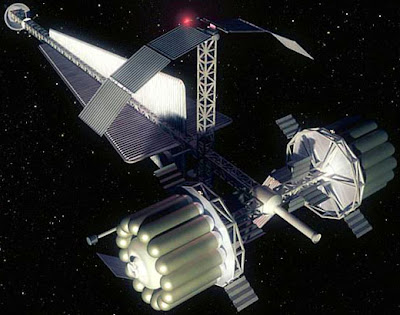Space Warfare IX: Could Everything We Know Be Wrong?

Or at least 'it depends?'
The broad mainstream tradition of space SF tradition is to treat planets as analogous to island countries, with their surrounding orbital space as 'offshore waters.' In the more picaresque settings an occasional orbital station around some backward colony planet might become a Free Haven, welcoming all comers with no questions asked and fewer answered. But as a rule, any planet that wants to count for anything controls its own orbital space. Or at least someone does, such as a trade federation.
In this type of setting, where entire regions of local space are normally under a single authority, any enemy must come from some other local region, arriving from deep space. The attackers might come from Mars, or Callisto, or Sigma Draconis IV, without really changing the story line.
And much of what I have said here follows from that assumption. An approaching deep space force can be detected at Stupendous Range, its orbit telegraphing its region of origin and therefore probably its intent. It can then be engaged at merely Enormous Range, at the translunar fringe of orbital space or even beyond.
But what if both the attacker and defender are in Earth orbital space to begin with?
In Cold War days there was a whole subgenre that dealt with orbital warfare, in a near future setting - back when that meant circa 1965 - and a Cold War context. Much more recently a micro-genre of alternate history rocketpunk has appeared, centering on World War II. The most notable example is Ministry of Space, but I believe there are others.
In fact an all out war between Earth powers would reduce Earth's inner orbital space to a no man's land. Low orbit is too vulnerable to surface-launched kinetics, and shuttle types are especially vulnerable during ascent and return. Forces in high orbit or deep space would be cut off from their home bases for the duration, on both sides. In an early-space setting they'd have plenty on their hands to survive, let alone conduct operations against each other.
But suppose that, in a century or two, Earth orbital space is home to a welter of stations, habs, ships, and other platforms. Some belong to national governments, some are jointly operated (like the ISS today), or belong in various ways to a host of entities such as NGOs and private firms. Over time, how these spacecraft are 'flagged' may have as little to do with actual ownership as it does at sea today.
Ships at sea have to put into port sooner or later, entering someone's territorial waters. Spacecraft, other than shuttle types, remain in space, merely docking with other spacecraft from time to time. In these circumstances, so long as someone can pay the bills a flag of convenience is barely short of outright autonomy.
I have discussed this previously in the context of rethinking space piracy, and have also discussed alternatives to the familiar 'Westphalian' world of absolute sovereign states.
Independent or quasi-independent space habs are as plausible in Earth orbital space (or Mars, etc.) as they are in the asteroid belt, and perhaps more so. The asteroids have raw material, but Earth and its orbital space have the markets (and source of immigrants). If cycler ships are used, Earth orbital space is probably the one destination they all call at each time around.
Most likely an ambiguous welter of authority in space will merely provide billable hours for lawyers. But if Earth orbital space is home to increasingly autonomous powers, they can have rivalries, crises, and potentially warfare. What would a war between rival stations or habs in Earth orbital space be like?
It would have to be 'limited,' because of the great vulnerability of spacehabs to attack. But this is true of civil space infrastructure wherever it is located, so it does not distinguish orbital warfare from any other kind of space warfare. Or, in the postnuclear age, from any kind of warfare that any player can hope to survive.
The most obvious difference from the familiar vision of interplanetary (or interstellar) warfare is that travel times are suddenly much shorter. As was noted in the comment thread on orbital combat, mission durations in orbital space look more 'air force' than 'navy.'
The space you are fighting in is also a lot more cluttered, including with neutrals. Of course, 'cluttered' is a relative term. Earth orbital space is vast, taking hours or days to cross at even at orbital speeds. But compared to the months of interplanetary travel it is cheek by jowl. And the clutter may include neutrals whom you do not wish to draw into the war.
Which changes a lot of familiar assumptions. Everyone sees everything? Not behind that big round planet they don't, unless they have an eye on the other side. But even more to the point, we can't see through ships' hulls, let alone human minds, and the change of time scale changes the sort of missions we may undertake.
Imagine a suspicious ship departing a neutral space station.
In a traditional setting, absent magical drives we couldn't do much more than log its orbit. Intercepting and inspecting it would take months. If human inspection is called for you'd need a fairly large ship for long term habitability, and you are committing ship and crew to that one mission for perhaps a year or so. Which means that such missions will be costly, and rare.
Now shift the story into Earth orbital space. Intercept and inspection mission can now be performed in hours to a few days, by a much smaller craft with only short term habitability - which makes such missions far more practical.
For the same reason the 'suspicious spacecraft' itself becomes more plausible. Slipping a covert military craft into the civil traffic flow is cumbersome when civil traffic is months en route. It works a lot better on a time scale of hours to a few days.
Even the manned space fighter starts to be plausible in this environment. Its role is not precisely analogous to an atmosphere fighter, more nearly to a helicopter gunship, for example escorting the craft that carry boarding and inspection teams.
Fighting could and probably will erupt not in the middle of nowhere, but in genuinely crowded space - even amid the constellation of spacecraft that surrounds any large commercial station. A demand is refused, negotiations go pear shaped, and suddenly shooting erupts.
Here we are fighting at Hollywood range, and with civil and neutral craft nearby, posing rules of engagement decisions not to be entrusted to garden variety robotics. Teleoperation is an uncertain option. Jamming can't be ruled out in these close situations - and when split second decisions matter, a little light lag goes a long ways.
Putting human pilots aboard your escort gunships is no longer frivolous.
This sort of space environment is not confined to Earth orbital space. It can appear wherever you have extensive traffic in a small region of space, with no one local power in a position to regulate it all.
No technological assumptions need to be changed to bring about this state of affairs, only political and social assumptions about who can travel where in space, and whether high traffic local regions of space are typically under a single local authority that can defend them (or attack other local regions) as a unity.
The meta point is that a lot of what I have said here about Realistic [TM] space warfare is driven not just by technology but by (hidden) assumptions about who is fighting and what they are fighting over. Change those assumptions and you may get surprising results.
Happy New Year, and have at it!
The excellent image is from Astronomy Picture of the Day.
Related links: Piracy in space, and post-Westphalian worlds.




















